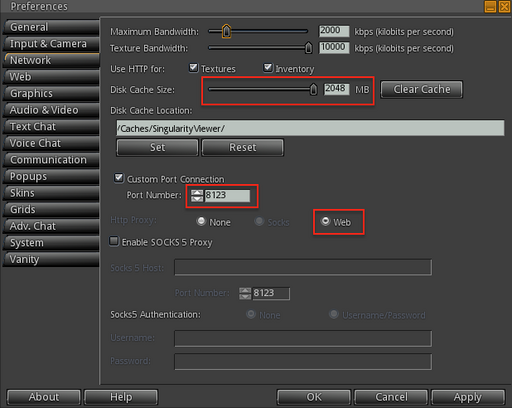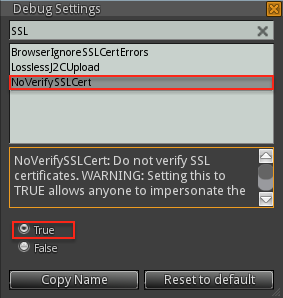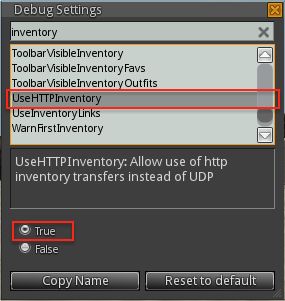Table of Contents
About
The following tutorial uses Squid bumping to intercept SSL Second Life grid traffic in order to be able to better cache assets. In other words, this tutorial will show you how to use Squid to intercept and decrypt the traffic between your viewer and the SecondLife grid with the purpose of caching assets (textures and others).
Requirements
You will need Squid v3.5+ with SSL compiled in and with the following compile-time features enabled:
--enable-ssl \
--enable-ssl-crtd
If your distribution is Debian, then you can probably follow the tutorial on compiling your own Squid.
Configuring Squid for SSL Bumping
First, run the command:
/usr/lib/squid3/ssl_crtd -c -s /var/lib/ssl_db
in order to create the certificate store.
On Debian, you will have to change the owner of the /var/lib/ssl_db to the proxy user that Squid runs under:
chown -R proxy:proxy /var/lib/ssl_db
The next part is to create the required certificate for SSL bumping by using OpenSSL:
openssl req -new -newkey rsa:2048 -sha256 -days 365 -nodes -x509 -extensions v3_ca -keyout myCA.pem -out /etc/squid/certs/myCA.pem
Some root certificates can be installed on Debian using:
aptitude install ca-certificates
to be used in the Squid configuration.
Finally, edit /etc/squid/squid.conf and amend the file with the following:
# Listening Port http_port 8123 ssl-bump cert=/etc/squid/certs/myCA.pem generate-host-certificates=on dynamic_cert_mem_cache_size=4MB # SSL Bump Config acl bump_domains dstdom_regex -i "/etc/squid/bump_domains.conf" acl DiscoverSNIHost at_step SslBump1 ssl_bump peek DiscoverSNIHost ssl_bump bump bump_domains ### SSL Tweaks # On Debian, from the package ca-certificates - not needed for Squid v4+ sslproxy_cafile /etc/ssl/certs/ca-certificates.crt sslproxy_cert_error allow all sslproxy_flags DONT_VERIFY_PEER sslcrtd_program /usr/lib/squid3/ssl_crtd -s /var/lib/ssl_db -M 8MB sslcrtd_children 5 # Do not forward bumped domains through cache peers. always_direct allow bump_domains never_direct allow !bump_domains # Rewrite lindenlab assets. acl rewritedoms dstdomain .agni.lindenlab.com store_id_program /etc/squid/secondlife_store_rewrite.py store_id_children 64 startup=10 idle=5 concurrency=0 store_id_access allow rewritedoms store_id_access deny all ### SecondLife-specific configuration parameters. # SecondLife Refresh patterns. refresh_pattern -i /cap/ 129600 100% 129600 ignore-no-cache ignore-no-store ignore-private override-expire override-lastmod reload-into-ims ignore-reload refresh_pattern -i asset-cdn\.agni\.lindenlab\.com/.* 129600 100% 129600 ignore-no-cache ignore-no-store ignore-private override-expire override-lastmod reload-into-ims ignore-reload refresh_pattern -i asset-cdn\.glb\.agni\.lindenlab\.com/.* 129600 100% 129600 ignore-no-cache ignore-no-store ignore-private override-expire override-lastmod reload-into-ims ignore-reload # Access log access_log /var/log/squid/access.log buffer-size=1MB # Useful for debugging store re-writes: shows GET query terms. strip_query_terms off
Now, all domains listed in /etc/squid/bump_domains.conf will be bumped so create the file /etc/squid/bump_domains.conf with the following contents:
(^|\.)lindenlab..+?$
Store Re-Write Script
The store re-write script will grab the UUID of the requested asset (either texture or mesh) and pass it to squid in a more palatable format. Using the configuration from the previous section, the script has to be placed at /etc/squid/secondlife_store_rewrite.py:
#!/usr/bin/python -u # http://vex.fabulo.us/2015/12/return-of-the-squid-or-how-to-have-a-terabyte-texture-cache-using-squid-3/ import re import sys # http://sim34232.agni.lindenlab.com/cap/foo/?texture_id=klkjalkjsd # http://asset-cdn.glb.agni.lindenlab.com/?texture_id=klklkjlkjs # group 1 is the host - simNNNN or a CDN server # group 2 is the port on the server # group 3 cap # group 4 is either 'texture' or 'mesh' # group 5 the actual id texturl_patt = re.compile('(.*)\.agni\.lindenlab\.com(.*)/(.*/?)\?(texture|mesh)_id=(.*)') def rewrite(texturl): m = texturl_patt.search(texturl) if m is not None: r = 'http://{}.lindenlab.com/{}'.format(m.group(4),m.group(5)) return r else: return None def process(line): if line == 'quit': sys.exit(0) stuff = line.split() if stuff[0].isdigit(): r = rewrite(stuff[1]) if r is not None: print('{} OK store-id={}'.format(stuff[0], r)) else: print('{} ERR'.format(stuff[0])) else: r=rewrite(stuff[0]) if r is not None: print('OK store-id={}'.format(r)) else: print('ERR') while True: line = sys.stdin.readline().strip() if not line: break process(line)
and granted execute permissions: chmod +x /etc/squid/secondlife_store_rewrite.py.
You can now save all configurations and restart Squid.
Configuring the Viewer
To make the viewer use the Squid proxy, and assuming the configuration from the previous section, a few parameters have to be set.
Preferences->Web->Web Proxy->Enable Web Proxy- should be ticked.Preferences->Web->Web Proxy->Address- fill in the address and port on which Squid is listening.
Preferences->Network->Custom Port Connection- this should be set to the samehttp_portconfigured for Squid (following the example, this should be8123)Preferences->Network->Http Proxy- should be set toWebbecause Squid does not support SOCKS connections.
If you save the settings now and attempt to connect, you will get and error telling you that the server certificate cannot be verified. This is because Squid is bumping the connection using the myCA.pem certificate. To resolve this issue, you can go to:
Advanced->Debug Settings
and type in: NoVerifySSLCert and set the toggle to True. The warning is fair, because intercepting the SSL session is exactly what you want to accomplish with Squid.
You should now be able to connect to SecondLife through Squid.
Optimizations
This section is viewer-specific but the general guideline is to enable:
- HTTP inventory
- HTTP textures
such that all all requests for inventory or textures will flow through Squid.
Checking
You should now be able to monitor /var/log/squid/access.log to see all the requests that the viewer is making whilst minding for TCP_MISS (asset not cached) and TCP_HIT or TCP_MEM_HIT indicating that the asset was previously cached.
If the option strip_query_terms has been set to off, you should be able to see the GET request parameters which is useful for amending the secondlife_store_rewrite.py script.
For the contact, copyright, license, warranty and privacy terms for the usage of this website please see the contact, license, privacy, copyright.








